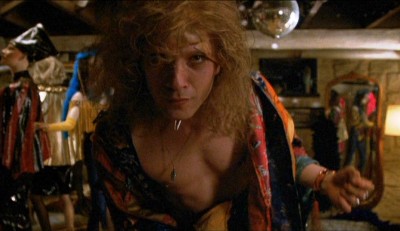Tag: Jonathan Demme
A part of this viewing list: Criterion Collection Spine #13: Jonathan Demme’s The Silence of the Lambs.
“Nothing is so frightening as what’s behind the closed door. The audience holds its breath along with the protagonist as she/he (more often she) approaches that door…”
Stephen King in Danse Macabre and before that Val Lewton

The Silence of the Lambs is all kinds of great. For a horror movie it offers relatively little gore, instead relying on what is not seen to grow the fear. The film pretty much uses one cinematic trick over and over throughout, but it never gets old. Demme’s choice to use a shallow depth of field and straight-on framing of the characters do much to strengthen the relationships between character dialogue and relationship, the constant scopophilic gaze directed by almost every man to Agent Starlng creates a deliberate and constant sense of unease to her subjectivity, and the myriad references to change and metamorphosis ensure that no one thing we know can be seen as certain.
But time and time again what gives the movie its pep is the closed door, the reveal, the passage through. The next time you see this film, count them. Doorways are liminal symbols, inherently unpredictable and the constant action of opening, passage and closing taken by Clarice reflects her own growth as an FBI agent. The viewer grows along with her and gratification is delayed in almost every scene; when we think we are about to make a discovery, only another door is revealed.
The climactic sequence of the film [if only I could find it online!] has well over twenty doors that must be passed through or at least identified as a possible source of terror for Clarice. Coupled with the unpredictability of Hannibal Lector’s mind and the ease with which he manipulates an entire investigation it should be no surprise that the viewer is just as easily manipulated by the editing in the lead-up to the Starling’s confrontation with Buffalo Bill. This is a film that has got our number, can fool us over and over with the same cinematic parlor tricks and leave us wanting more. Hitchcock, who I had initially thought of as the man who made the closed door quote, would have been proud.
The other main strength of the film is the acting. Just about everyone is superbly creepy. This might be due to the fact that just as nearly everyone is a man and we are often encased within Agent Starling’s worldview as the object of desire, but even the bit-part actors are awash in uncanniness that is all the more effective because it is so natural. We all know people who are that sort of weird. The relationship between Lector and Starling is often that of a snake hypnotizing a bird. Certainly Anthony Hopkins acting is makes the film extra extraordinary and the quality of everyone else buoys his performance up even higher. I really have no criticisms of this film, it is so cruftless, polished and so effective at what it does that I can’t think of much else to say.

- Criterion Essay by Amy Daubin.
- Roger Ebert review.
- *.wav clips from the film.
- Outtakes on YouTube.
- Jodie Foster on Inside the Actor’s Studio talking about the film. [YouTube]
- The Criterion Contraption’s review.